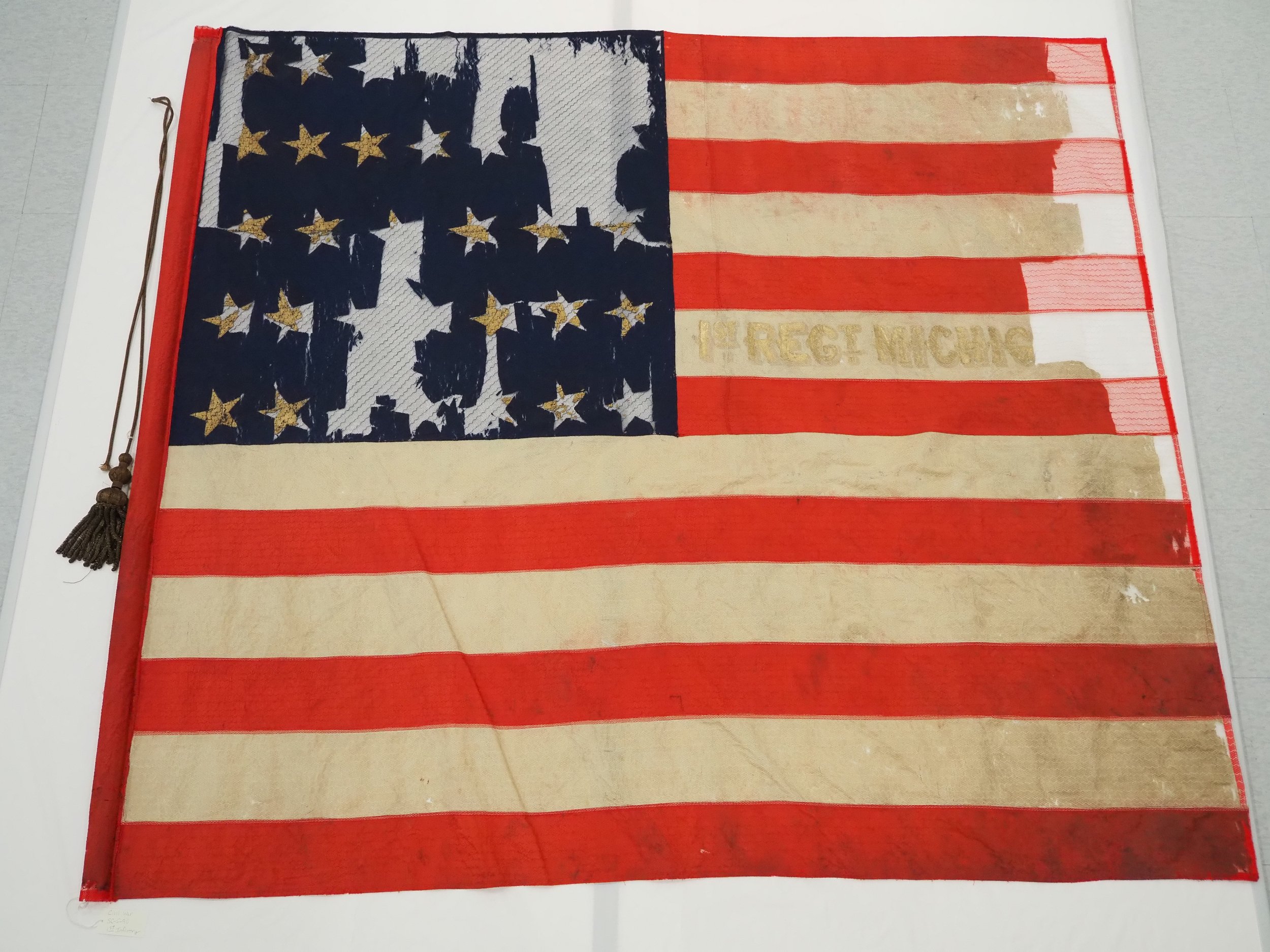
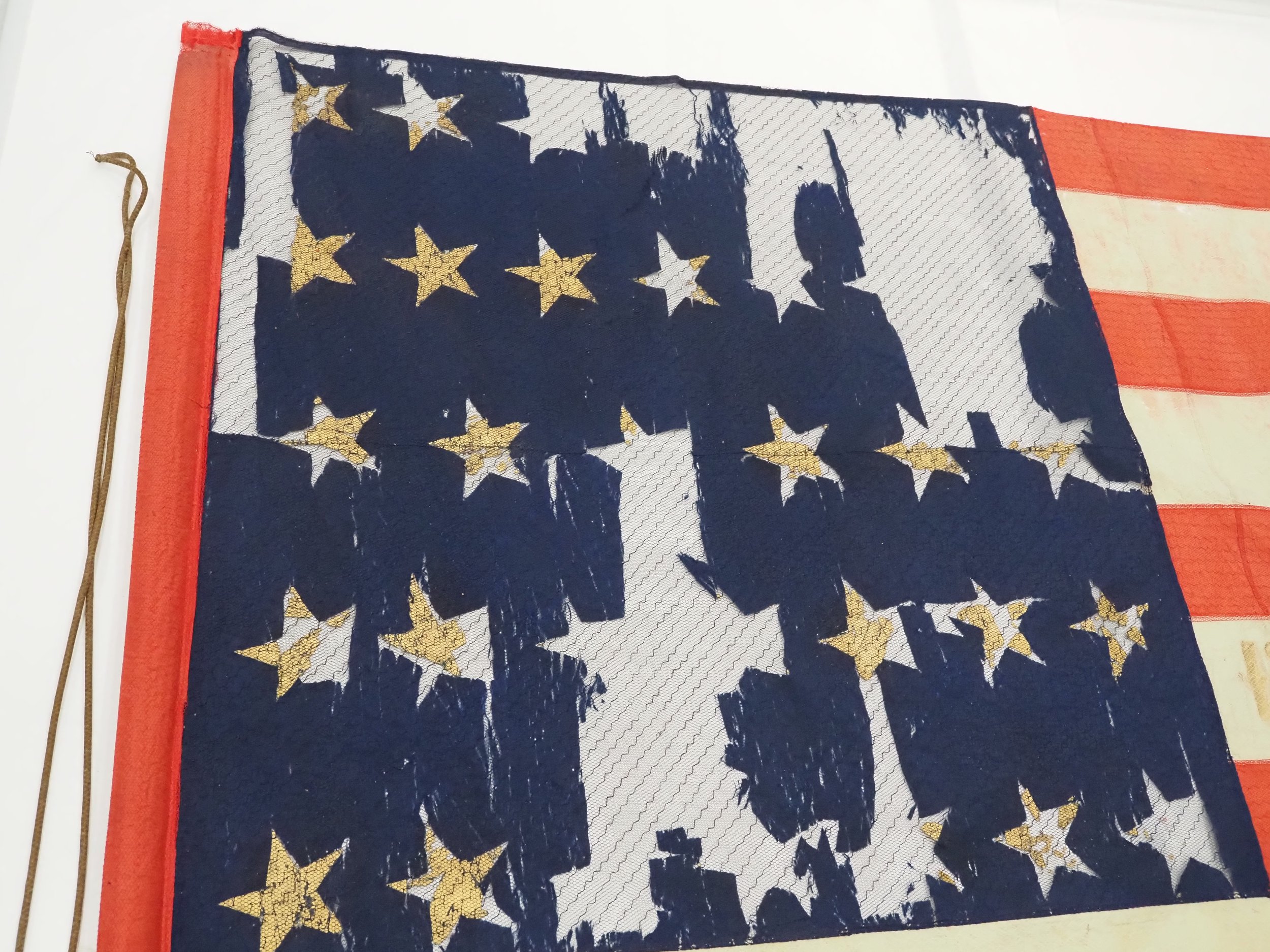
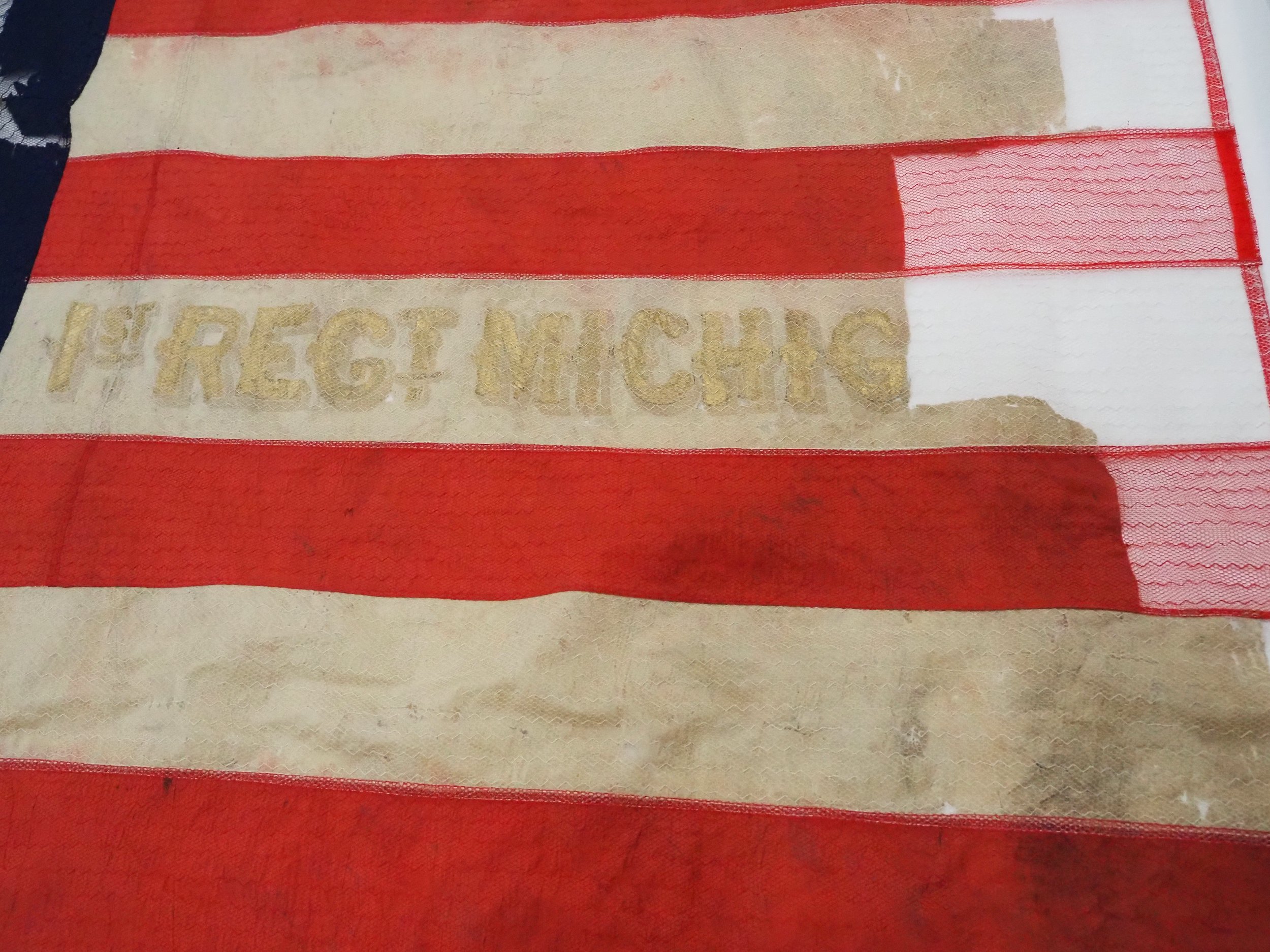


1st Michigan 3-Year Volunteer Infantry
SC-5-90: Silk national ▪ Dimensions: 67”x 75”
Description:
Although the blue canton is not intact and many of the five-pointed, gold painted stars are missing, the star pattern is consistent with other thirty-four-star flags in the collection with four rows of seven stars each and a middle row of six stars. This arrangement indicated that it was produced in the early years of the war, prior to West Virginia’s entry into the Union in 1863, which added a thirty-fifth star. On the third white strip from the top is painted in gold “1st REG. MICHIG[AN]” The painted portion reads correctly on the obverse (front) and incorrectly on the reverse (back). The fabric on the hoist was fashioned into a sleeve for attachment to the staff, although this fabric is not a part of the whole silk, but rather a separate piece stitched onto the flag for attachment to the staff.
The staff, which measures 97” long x 1 ¼” in diameter is intact, with a gold painted wood spear finial. The staffs of flags returned to the state at the 1866 Detroit ceremony marking the end of the war, all bear identical brass plaques. The brass plaque reads in Spencerian script “1st Mich. Infantry.”
One tassel remains. The twisted green and gold cord measures 78” long and the gold bullion tassel is formed on a wooden core and measures 2 ¼”.
The flag was netted (sewn between layers of dyed net) in the 1960s in an early attempt at conservation.
Adoption:
July 29, 2018 - Bruce and Terri Miller
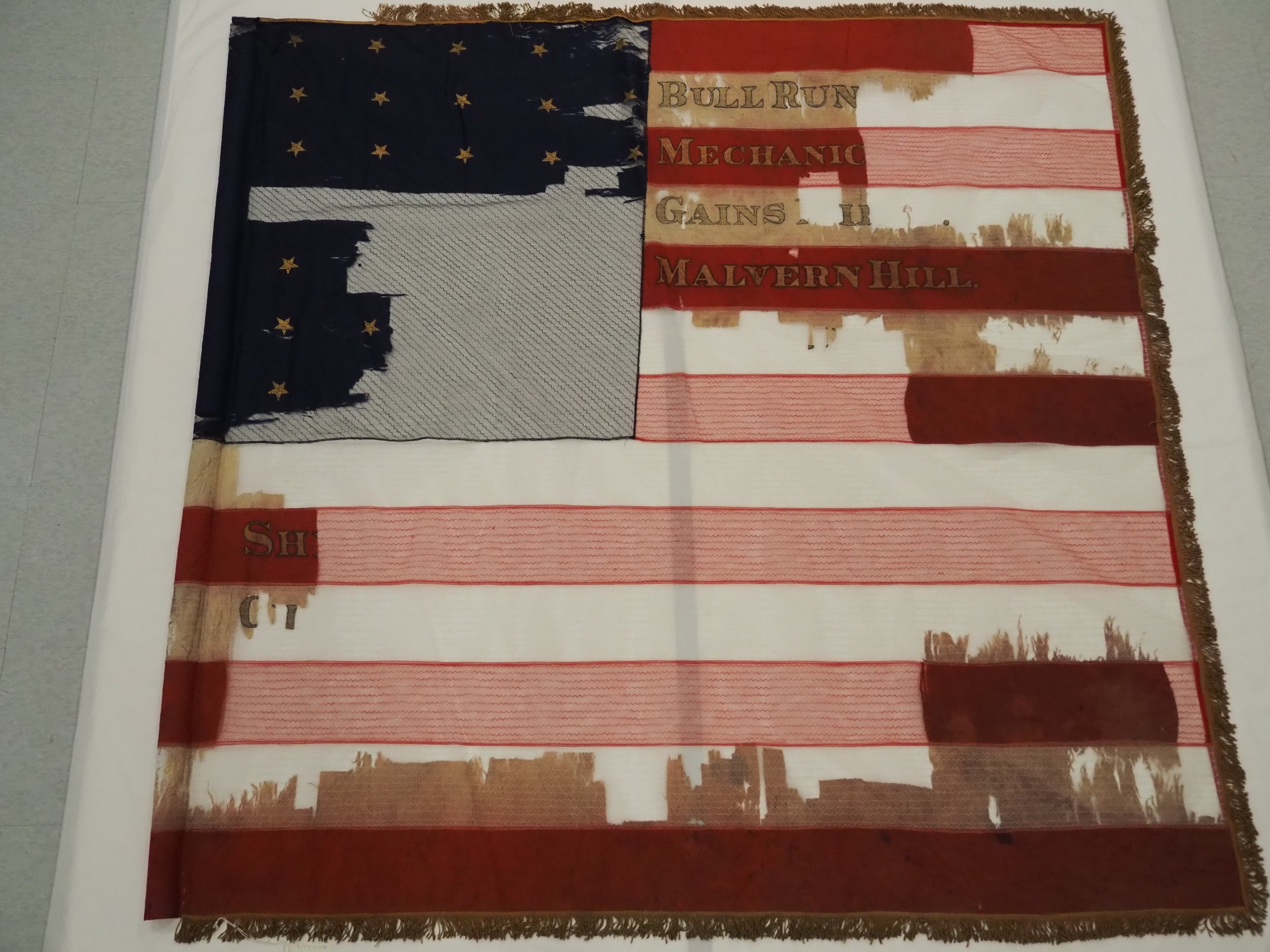




1st Michigan 3-Year Volunteer Infantry
SC-6-90: Silk national ▪ Dimensions: 70”x 70” ▪ Silk Fringe: 1.75”
Description:
This flag is likely a replacement flag that was given to the regiment on April 22, 1864 as it is the only flag in the collection to have the battle honors listed in a newspaper article from the time. The blue canton of the flag is not intact and many of the five-pointed, gold painted stars are missing, making establishment of a star pattern and number difficult. Painted in gold block lettering and outlined in black are battle honors, starting on the first white strop from the top: “BULL RUN, MECHANIC[SVILLE], GAINS [MILL], MALVERN HILL, SH[EPARDSTOWN FORD?]” The flag has gold silk knotted fringe. The fabric on the hoist was fashioned into a sleeve for attachment to the staff.
The staff which measures 97” x 1.25” in diameter is intact with a gold orb finial. The staff of flags returned to the state in 1866 Detroit ceremony marking the end of the war all bear identical brass plaques. The plaque reads in Spencerian script, “1st Mich. Infantry.”
No tassels or cord remain.
The flag was netted (sewn between layers of dyed net) in the 1960s in an early attempt at conservation.
Adoption:
July 17, 2013 - Bruce and Terri Miller

1st Michigan 3-Year Volunteer Infantry
SC-7-90 Two silk swallowtail national guidons on one staff, probably used as flank markers.
Flag 1: Dimensions: 25”x37.5” (to extremity of the swallowtail)
Flag 2: Dimensions: 25”X38.5” (to extremity of the swallowtail)
Description:
Flag one has thirty-five, five-pointed stars painted on the canton in concentric circles with twelve stars in the inner circle and nineteen stars in the outer circle, and one star in each corner. The fabric on the hoist was fashioned into a sleeve for attachment to the staff.
Flag two has thirty-five, five-pointed stars painted on the canton in concentric circles with twelve stars in the inner circle and nineteen stars in the outer circle, and one star in each corner. The canton is a lighter blue than that of flag one. The fabric on the hoist was fashioned into a sleeve for attachment to the staff.
The staff, which measures 98.25” long x 1.25” in diameter is intact with gold metal spade finial. The staffs of flags returned to the state at the 1866 Detroit ceremony marking the end of the war all bear identical brass plaques. The brass plaque reads in Spencerian script “1st Mich. Infantry.”
No tassels, or cords remain.
The flags were netted (sewn between layers of dyed net) in the 1960s in an early attempt at conservation. In the Summer of 2023, conservation specialists at the capitol began more modern conservation work in lab in Heritage Hall.
Adoption:
July 29, 2018 - Bruce and Terri Miller


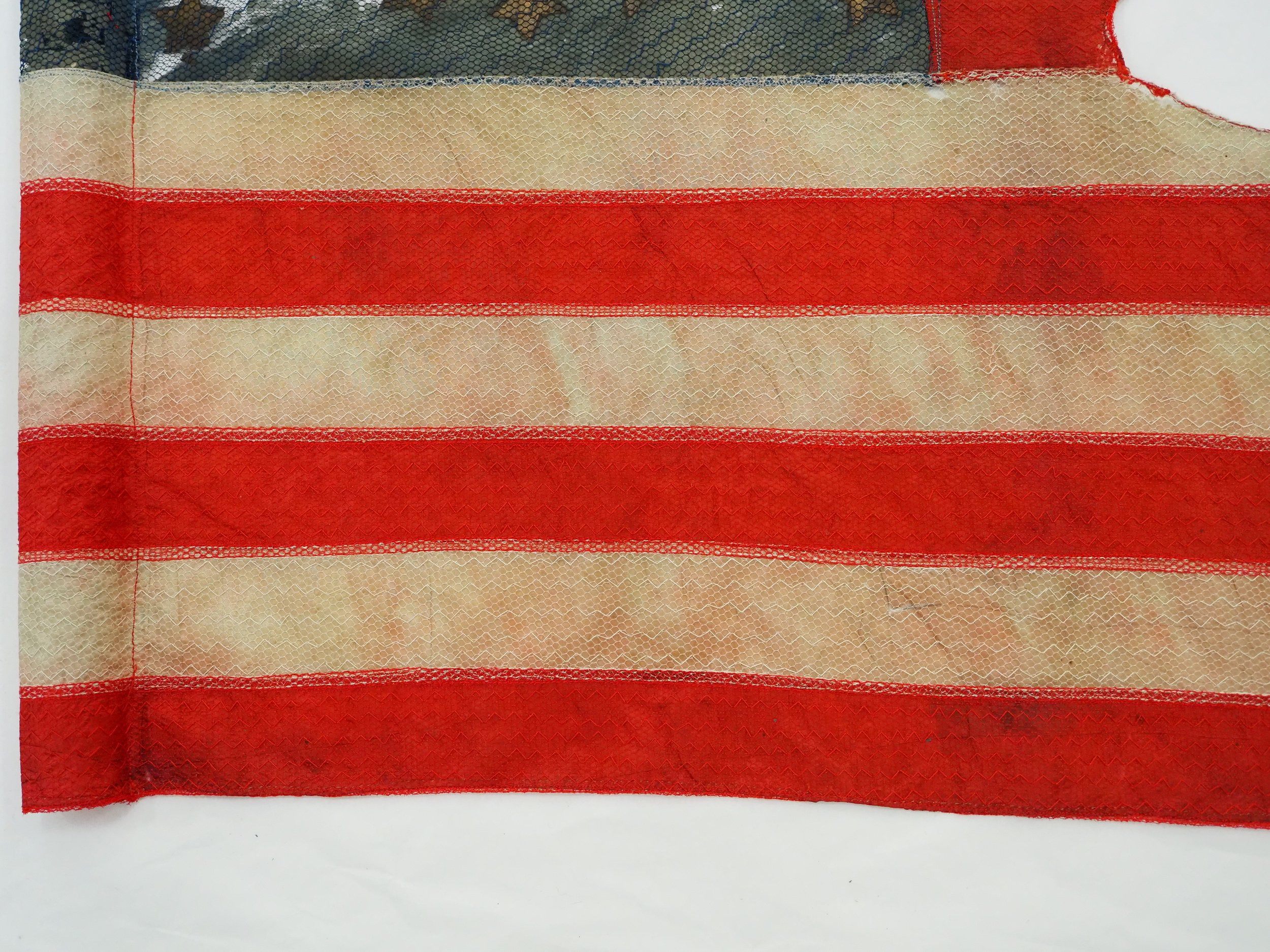

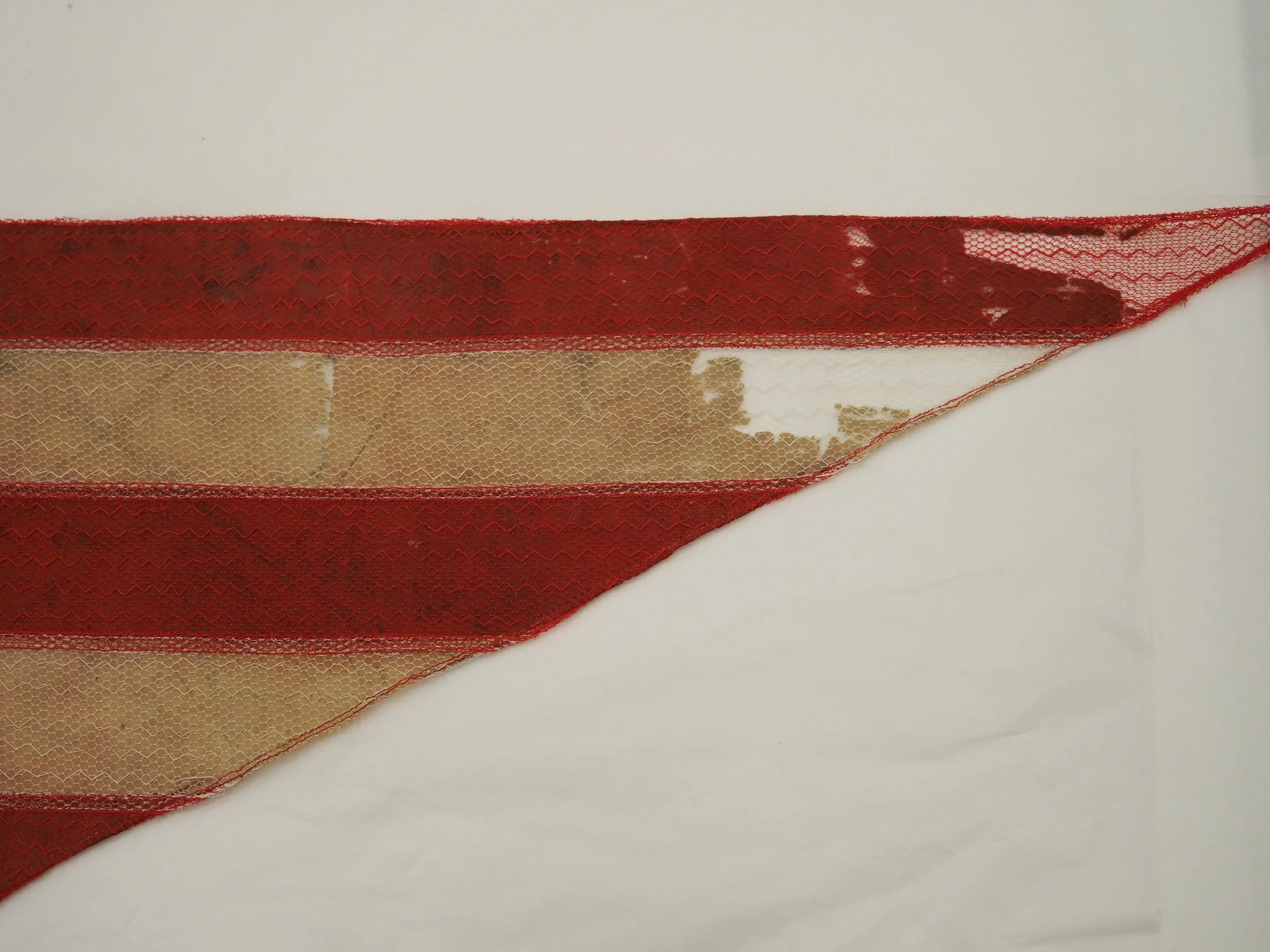
1st Michigan 3-Year Volunteer Infantry
SC-17-90: Silk swallowtail national guidon ▪ Dimensions: 25”x 40”
Description:
The flag is a swallowtail national flag and was probably used by the regiment as a flank marker. It has thirty-five, five-pointed stars painted on the canton in concentric circles with twelve stars in the inner circle and nineteen stars in the outer circle, and one star in each corner. The fabric on the hoist was fashioned into a sleeve for attachment to the staff.
The staff which measures 97” long x 1.25” in diameter, is intact with a gold metal spade finial. The staffs of flags returned to the state at the 1866 Detroit ceremony making the end of the war all bear identical brass plaques. The brass plaque in Spencerian script reads, “1st Mich. Infantry.”
No tassels or cords remain.
The flag was netted (sewn between layers of dyed net) in the 1960s in an early attempt at conservation.
Adoption:
July 29, 2018 - Bruce and Terri Miller




1st Michigan 3-Year Volunteer Infantry
SC-18-90: Silk national ▪ Dimensions: 69.5”x 74” ▪ Gold Bullion Fringe: 2.5”
Description:
Although the blue canton is not intact and many of the five-pointed, silver embroidered stars are missing, the star pattern is consistent with other thirty-four-star flags in the collection, with four rows of 6 stars and two center rows of five stars. On the fourth red strip from the top is embroidered in silver Gothic lettering “1st Michigan Inf.” The flag has gold bullion fringe which is partially intact. Five cloth ribbons were added (presumably during the 1960’s) for attachment to the staff.
The staff, which measures 98” long x 1.5” in diameter is intact, with a gold, metal spade finial. The staffs of flags returned to the state at the 1866 Detroit ceremony marking the end of the war all bear identical brass plaques. The brass plaque in Spencerian scrip reads “1st Mich. Infantry”.
No tassels or cords remain.
The flag was netted (sewn between layers of dyed net) in the 1960s in an early attempt at conservation.
Adoption:
May 21, 1997 - Quakertown Questers, Chapter 115
Bruce and Terri Miller
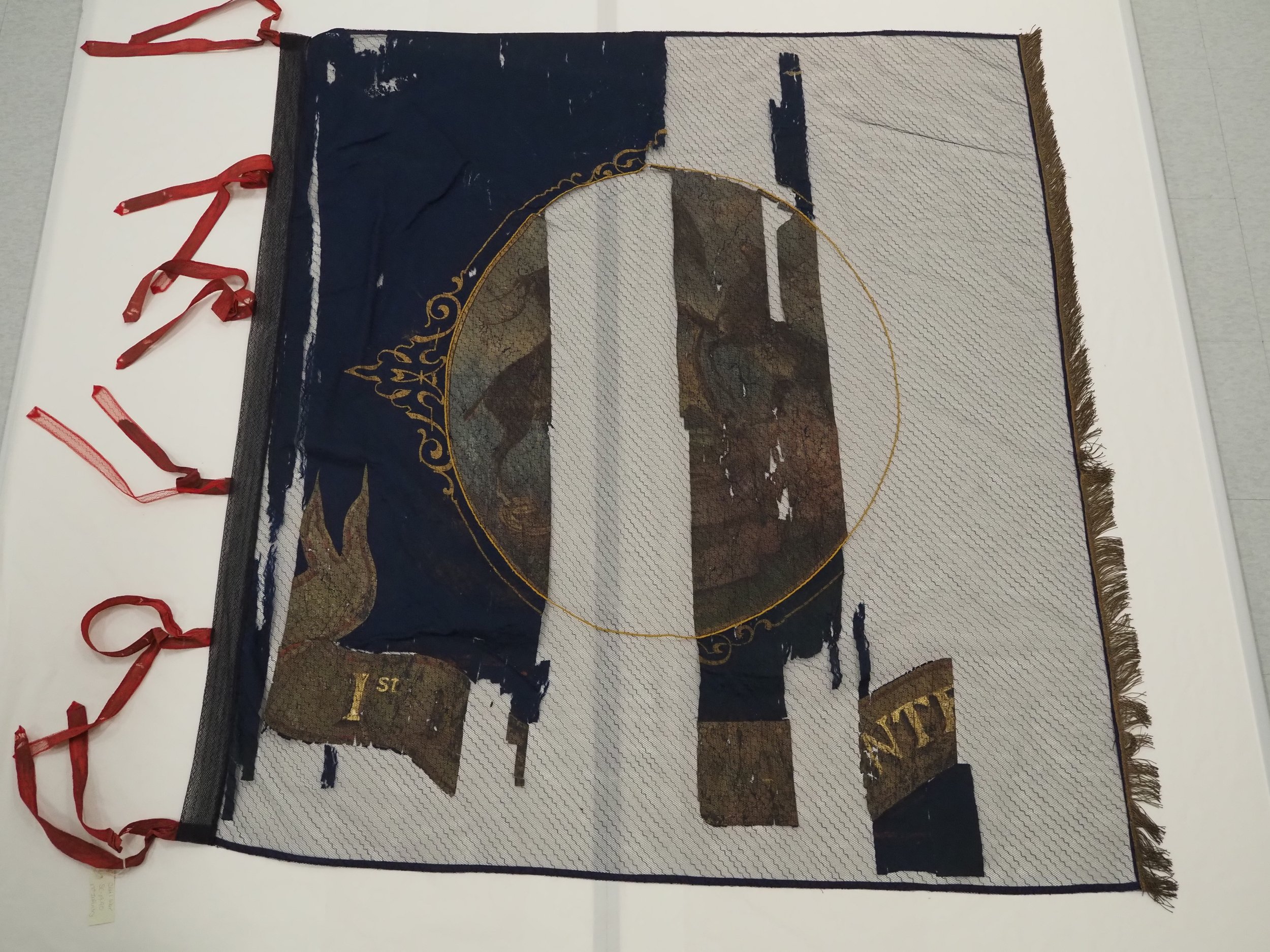
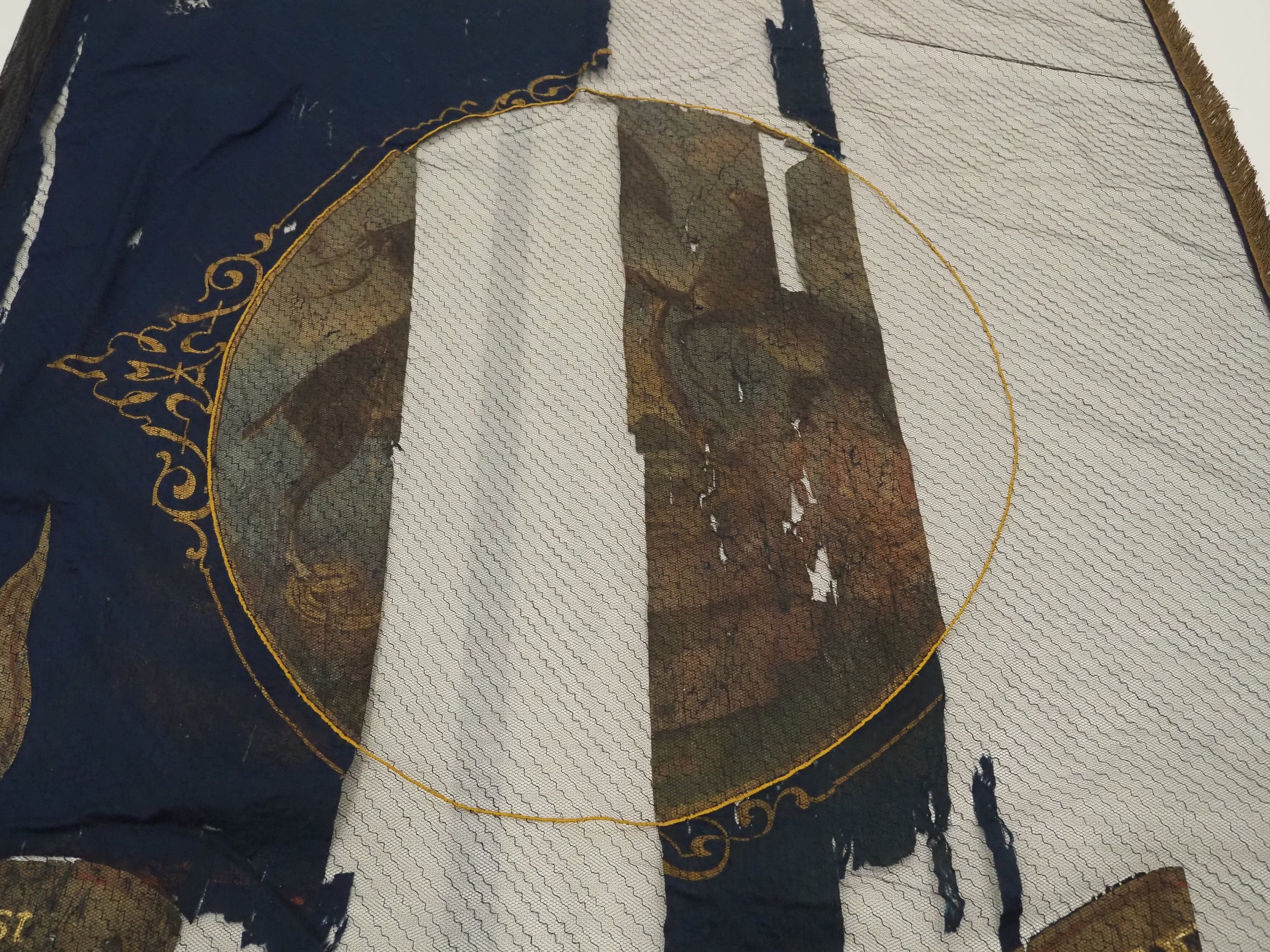



1st Michigan 3-Year Volunteer Infantry
SC-19-90: Silk state regimental ▪ Dimensions: 61”x 61” ▪ Gold Bullion Fringe: 2.5”
Description:
The partially intact flag has a dark blue field consisting of a single layer of silk and painted. The obverse (front) is charged with a painted red scroll with the regimental designation (only part of which remains). Above the designating scroll, the flag is charged with a painted rendering of the Michigan coat-of-arms. It features an eagle (partial remaining) with outstretched wings. The eagle rests atop a shield (partial remaining). The shield is supported on the left and right by elk (partial remaining) both rampant. The reverse (back) is charged with the national emblem, featuring an eagle (partial remaining) with outstretched wings perched atop the federal shield (partial remaining). Beneath the shield is a painted scroll with the regimental designation (partial remaining). As a result of the single layer construction, some of the painted areas on the obverse have “bled” through the silk and can be seen on the reverse and some of the painted areas on the reverse have also “bled” through the silk and can be seen on the obverse side. The result of this “bleeding” has the unfortunate effect of obscuring some of the painted areas on both sides of the flag. The flag has gold bullion fringe that is partially intact. Six cloth ribbons were sewn to the flag for attachment to the staff.
The staff which measures 96” long x 1.5 in in diameter is intact, with a gold, metal orb finial (partially intact). The staffs of flags returned to the state at the 1866 Detroit ceremony celebrating the end of the war all bear identical brass plaques. There is no plaque on this staff indicating that it may have been turned over to the state at a later time.
No tassels or cords remain.
The flag was netted (sewn between layers of dyed net) in the 1960s in an early attempt at conservation. The ribbons were also netted at this time.
Adoption:
February 7, 2017 - Bruce and Terri Miller




1st Michigan 3-Year Volunteer Infantry
SC-20-90: Silk national ▪ Dimensions: 71”x 76” ▪ Silk Fringe: 1.75”
Description:
The flag has thirty-five painted gold stars in the blue canton arranged in two concentric ovals with ten stars in the inner oval, twenty stars in the outer oval, and a star in each corner and in the center of the canton. This indicates that it was carried in the later part of the war, after West Virginia became a state. The flag has gold silk knotted fringe. Fabric on the hoist was fashioned into a sleeve for attachment to the staff.
The staff, which measures 97” long x 1.25” in diameter is intact with a gold spade finial. The staffs of flags returned to the state at the 1866 Detroit ceremony marking the end of the war all bear identical brass plaques. The brass plaque reads in Spencerian script “1st Mich. Infantry.”
No tassels or cords remain.
The flag was netted (sewn between layers of dyed net) in the 1960s in an early attempt at conservation.
Adoption:
February 7, 2017 - Bruce and Terri Miller





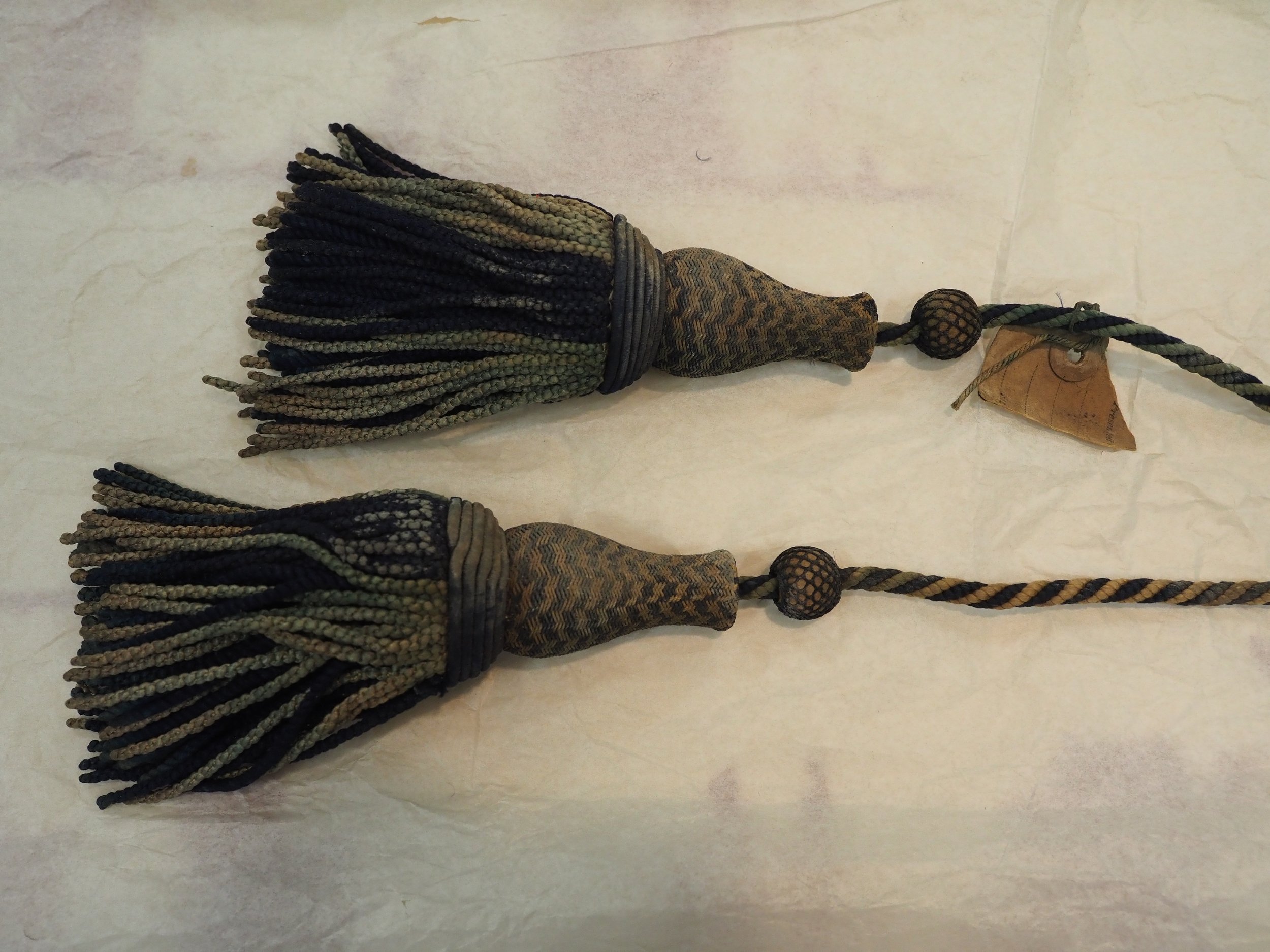
1st Michigan 3-Year Volunteer Infantry
SC-219-90: Silk national ▪ Dimensions: 77”x 79” ▪ Silk Fringe: 2.5”
Description:
Although the canton is not intact and many of the five-pointed, gold, painted stars are missing, the star pattern is consistent with other thirty-five star flags in the collection. With these flags, the stars are arranged in two concentric ovals with ten stars in the inner oval and twenty in the outer oval, one star in each corner, and one star in the center. The flag has silk gold knotted fringe which is partially intact. The fabric on the hoist was fashioned into a sleeve for attachment to the staff.
There is no staff accompanying this flag, instead it was stored in a box for many years.
No tassels or cord remain.
In 1999 the flag was conserved by Textile Preservation Associates and was stabilized between layers of shear Stabiltex.
Adoption:
February 7, 2017 - Richard and Janice Cross
